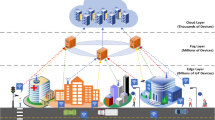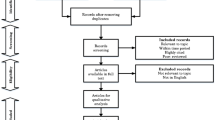Abstract
With the growing demand and commercial availability of cloud services, the need for comparison of their functionality against different prices and performance has arisen. A relevant and fair comparison is still challenging due to diverse deployment options and dissimilar features of different services. This paper addresses a hybrid multi-criteria decision-making model involving the selection of cloud services among the available alternatives. The proposed methodology assigns various ranks to cloud services based on the quantified quality-of-service parameters using a novel extended Grey Technique for Order of Preference by Similarity to Ideal Solution integrated with analytical hierarchical process. Further, we analyse the proposed cloud service selection method in terms of sensitivity analysis, adequacy under change in alternatives, adequacy to support group decision-making, and handling of uncertainty. This analysis helps both researchers and practitioners for analysing more fruitful approaches for cloud service selection.







Similar content being viewed by others
Notes
References
Bedi P, Kaur H, Gupta B (2012) Trustworthy service provider selection in cloud computing environment. In: Proceedings of the 2012 international conference on communication systems and network technologies, pp 714–719
Buyya R, Yeo CS, Venugopal S, Broberg J, Brandic I (2009) Cloud computing and emerging IT platforms: vision, hype, and reality for delivering computing as the 5th utility. Future Gener Comput Syst 25(6):599–616
Capuano N, Chiclana F, Fujita H, Herrera-Viedma E, Loia V (2017) Fuzzy group decision making with incomplete information guided by social influence. IEEE Trans Fuzzy Syst, pp 1–1, https://doi.org/10.1109/TFUZZ.2017.2744605
Capuano N, Loia V, Orciuoli F (2017) A fuzzy group decision making model for ordinal peer assessment. IEEE Trans Learn Technol 10(2):247–259
Carrasco RA, Sánchez-Fernández J, Muñoz-Leiva F, Francisca Blasco M, Herrera-Viedma E (2017) Evaluation of the hotels e-services quality under the user’s experience. Soft Comput 21(4):995–1011
Chandrashekar J, Gangadharan GR, Buyya R (2016) Computational intelligence based qos-aware web service composition: a systematic literature review. IEEE Trans Serv Comput. https://doi.org/10.1109/TSC.2015.2473840
Christopher Frey H, Patil SR (2002) Identification and review of sensitivity analysis methods. Risk Anal 22(3):553–578
Cusumano M (2010) Cloud computing and SaaS as new computing platforms. Commun ACM 53(4):27–29
De Assunção MD, di Costanzo A, Buyya R (2010) A cost-benefit analysis of using cloud computing to extend the capacity of clusters. Cluster Comput 13(3):335–347
Deng JL (1982) Control problems of grey systems. Syst Control Lett 1(5):288–294
Deng JL (1988) Properties of relational space for grey systems. In Essential topics on grey system theory and applications. China Ocean Press
Di Martino B, Cretella G, Esposito A (2017) Cloud services composition through cloud patterns: a semantic-based approach. Soft Comput 21(16):4557–4570
Enea M, Piazza T (2004) Project selection by constrained fuzzy ahp. Fuzzy Optim Decis Mak 3(1):39–62
Esposito C, Ficco M, Palmieri F, Castiglione A (2016) Smart cloud storage service selection based on fuzzy logic, theory of evidence and game theory. IEEE Trans Comput 65(8):2348–2362
Garg SK, Versteeg S, Buyya R (2013) A framework for ranking of cloud computing services. Future Gener Comput Syst 29(4):1012–1023
Godse M, Mulik S (2009) An approach for selecting software-as-a-service (SaaS) product. In: Proceedings of the IEEE international conference on cloud computing, pp 155–158
Hajji MA, Mezni H (2017) A composite particle swarm optimization approach for the composite saas placement in cloud environment. Soft Comput https://doi.org/10.1007/s00500-017-2613-8
Hwang CL, Yoon K (1981) Multiple attribute decision making: methods and applications. Springer, New York
Jatoth C, Gangadharan GR, Fiore U (2017) Evaluating the efficiency of cloud services using modified data envelopment analysis and modified super-efficiency data envelopment analysis. Soft Comput 21(23):7221–7234
Kabir G, Hasin M (2012) Comparitive Analysis of TOPSIS and FUZZY TOPSIS for the evalution of travel website service quality. Int J Qual Res 6(3):657–675
Khan H, Faisal MN (2015) A Grey-based approach for ERP vendor selection in small and medium enterprises in Qatar. Int J Bus Inf Syst 19(4):465–487
Kumar RR, Mishra S, Kumar C (2017) Prioritizing the solution of cloud service selection using integrated mcdm methods under fuzzy environment. J Supercomput 73(11):4652–4682
Li A, Yang X, Kandula S, Zhang M (2010) Cloudcmp: comparing public cloud providers. In: Proceedings of the 10th ACM SIGCOMM conference on internet measurement. ACM, New York pp 1–14
Li GD, Yamaguchi D, Nagai M (2007) A grey-based decision-making approach to the supplier selection problem. Math Comput Modell 46(3):573–581
Lima FRJ, Osiro L, Carpinetti LCR (2014) A comparison between fuzzy AHP and fuzzy TOPSIS methods to supplier selection. Appl Soft Comput 21:194–209
Lin YH, Lee PC, Ting HI (2008) Dynamic multi-attribute decision making model with grey number evaluations. Expert Syst Appl 35(4):1638–1644
Liu S, Chan FT, Ran W (2016) Decision making for the selection of cloud vendor: an improved approach under group decision-making with integrated weights and objective/subjective attributes. Expert Syst Appl 55:37–47
Lo CC, Chen DY, Tsai CF, Chao KM (2010) Service selection based on fuzzy TOPSIS method. In: Proceedings of the IEEE 24th international conference on advanced information N/W and applications workshops (WAINA), pp 367–372
Oztaysi B (2014) A decision model for information technology selection using AHP integrated TOPSIS-grey: the case of content management systems. Knowl Based Syst 70:44–54
Pernici B, Siadat SH (2011) Selection of service adaptation strategies based on fuzzy logic. In: Proceedings of the IEEE world congress on services (SERVICES), pp 99–106
Saaty T (1980) Fundamentals of decision making and priority theory with analytical hierarchical process, vol 6. RWS Publications, University of Pittsburgh, Pittusburgh
Saaty T (2001) Decision making with dependence and feedback: the analytic network process : the organization and prioritization of complexity. In Analytic hierarchy process series. RWS publications, Pittsburgh
Saaty TL (1988) What is the analytic hierarchy process? In: Mathematical models for decision support. Springer, Heidelberg, pp 109–121
Sadeghi M, Razavi SH, Saberi N (2013) Application of grey TOPSIS in preference ordering of action plans in balanced scorecard and strategy map. Informatica 24(4):619–635
Saltelli A, Chan K, Scott EM et al (2000) Sensitivity analysis. Wiley, New York
Saripalli P, Pingali G (2011) MADMAC: multiple attribute decision methodology for adoption of clouds. In: Proceedings of the IEEE international conference on cloud computing, pp 316–323
Shivakumar U, Ravi V, Gangadharan GR (2013) Ranking cloud services using fuzzy multi-attribute decision making. In: Proceedings of the IEEE international conference on fuzzy systems, pp 1–8
Sidhu J, Singh S (2017) Improved topsis method based trust evaluation framework for determining trustworthiness of cloud service providers. J Grid Comput 15(1):81–105
Sun L, Ma J, Zhang Y, Dong H, Hussain FK (2016) Cloud-fuser: fuzzy ontology and mcdm based cloud service selection. Future Gener Comput Syst 57:42–55
Tran VX, Tsuji H, Masuda R (2009) A new QoS ontology and its QoS-based ranking algorithm for web services. Simul Model Pract Theory 17(8):1378–1398
Wang Q, Wu H (1998) The concept of grey number and its property. In: Proceedings of the NAFIPS, pp 45–49
Zheng Z, Wu X, Zhang Y, Lyu MR, Wang J (2013) QoS ranking prediction for cloud services. IEEE Trans Parallel Distrib Syst 24(6):1213–1222
Author information
Authors and Affiliations
Corresponding author
Ethics declarations
Ethical approval
This article does not contain any studies with human participants or animals performed by any of the authors.
Conflicts of interest
All authors declare that they have no conflict of interest.
Additional information
Communicated by V. Loia.
Rights and permissions
About this article
Cite this article
Jatoth, C., Gangadharan, G.R., Fiore, U. et al. SELCLOUD: a hybrid multi-criteria decision-making model for selection of cloud services. Soft Comput 23, 4701–4715 (2019). https://doi.org/10.1007/s00500-018-3120-2
Published:
Issue Date:
DOI: https://doi.org/10.1007/s00500-018-3120-2




